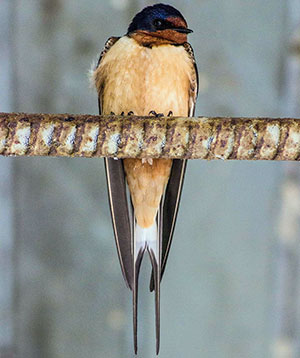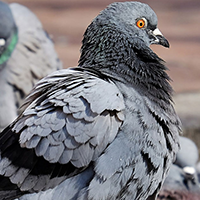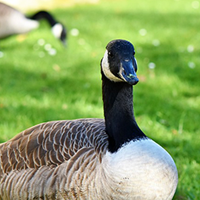Do you have swallows nesting in your industrial or commercial property or on your construction site? If you need them removed, you must follow specific guidelines per the Ministry of Natural Resources and Canadian Wildlife Services. Hawkeye Bird and Animal Control can help you obtain the right permits, provide abatement services and build you alternative housing for swallows if allowed or required.
Swallows are very fast and agile birds and it is rare to see them not in flight. With that being said, identification can be extremely difficult for a novice birder or even for someone with more experience. Swallows eat small insects and can capture them during flight. The Ministry of Natural Resources has deemed barn swallows and bank swallows as threatened species. This means they are not yet endangered but are at risk of endangerment if measures are not taken to save them.
In Ontario we have 6 types of swallows; Barn swallow, Bank swallow, Cliff swallow, Tree swallow, Northern rough-winged swallow, and Purple martin. But what type of swallow do you have nesting on your property and how do you tell the difference? Each swallow has their own distinctive physical attributes, but their habitat and nesting style can also be telling. Please go through the various types of swallows listed below to get a better idea of what type of swallows you are dealing with on your property.
Barn Swallow (see below) | Cliff Swallow | Bank Swallow | Other Swallows
 Barn Swallows
Barn Swallows
Mitigation of the Problem
What you need to know about Nest Relocation
Because swallows are protected by the Ministry of Natural Resources there are regulations around removing access to their nests, disturbing their habitat and deterring them from a property.
Typically, if you are provided a permit to complete work and remove a nesting area, you must:
- Minimize the effects of your activity on the barn swallows (Nests may only be removed before May 1 and after August 31 in any year
- Create and maintain new habitat including nests for the birds for a minimum of 3 years
- Provide alternative housing at a 1:1 ratio for every nest removed
- Report any sightings of rare species to the MNR
- Monitor the habitat you create
- Prepare and maintain records relating to the habitat and its activities
A nest sized container that may be used by barn swallows is typically made of wood, although other materials may be used. Barn swallows usually reuse old nests and freshen it by replacing old feathers with new and patching with new mud where necessary. Artificial nests mimic real nests, and should be made or bought in the following approximate dimensions: 25cm circumference, 13cm diameter, 1.5 cm thicknesses, about 4 cm heights. Nest cups are available commercially or may be made usually of wood. The nests can be installed in the building or structure from which the original came as long as the building or structure continues to provide suitable nesting conditions.
The nests can be installed in any building or structure that is within one km of the original building if it provides suitable conditions for barn swallow nesting.
The nests can also be installed in any building or structure that you can erect within one km of the original structure that meets the requirements of the MNR regulations. Suitable Nesting Conditions Buildings or structures that have been constructed or modified to create nesting habitat for barn swallows must have suitable conditions for nesting which include:
- Horizontal ledges or rough vertical surfaces with a sheltered overhang
- Enough surface area suitable for nest attachment at a height to minimize disturbances and away from predators
- Easy entry and exit to the nests
- Suitable area to accommodate appropriate spacing with nests
- Structurally sound and capable of providing habitat on a long term basis for the barn swallow.
The Ministry of Natural Resources requires permits for any work involving Barn swallows if you are altering, tearing down or changing in any way a structure that has nests in it or on it. If barn swallow nests need to be moved for health and safety reasons authorization is still required from the MNR prior to proceeding with any activity. If you do not follow the rules you will be breaking the law and can be charged.
What can Hawkeye do to help?
Hawkeye uses techniques like birds of prey and other scare tactics including bangers/pyrotechnics and exclusion measures to effectively prevent nesting. Hawkeye Bird and Animal Control will assist you in this process to ensure you have the applicable permits required to create an alternative housing option for the barn swallows. We will also use the proper equipment like man lifts and face masks and complete the tedious daily removal routines of any material before the swallows come back to re-nest.
Our birds of prey fly near open doors and prevent access of swallows. Contact Hawkeye today for a free assessment.
Range and Habitat
In Ontario, Barn swallows are found mostly in the southern reaches, but are also very widespread across North America, Asia, Europe, Africa, and South America. To provide barn swallow mitigation, a permit and the creation of alternative housing must be completed before you can remove, relocate nests or deter the birds from your property. While pictures of them capture what appears to be a beautiful little bird, for many industries or businesses, their nesting habits can turn them into a pest bird. They commonly find their way into parking garages, structures, covered areas of industrial areas, overhangs from roofs, bridges, culverts and much more. They create a unique nest from other birds by using mud to create a cup nest. But before getting into their nesting style, we first need to be able to identify what a barn swallow looks like.
Physical Attributes
The most telling feature of a barn swallow is its fantastical ‘V’ shaped forked tail. The colouration of the barn swallow is very unique and unmistakable with an iridescent dark cobalt blue nape, back, and rump accompanied by a burnt orange forehead, chin, and throat. The under body of a barn swallow can range from white to chestnut coloured depending on the sex of the bird; female to male respectively. Since these birds are quick fliers, your best bet for identification is looking for this distinctive tail while flying as they are the only swallow in Ontario that have this tail shape.
Nesting and Diet Habits
Barn swallows build their nests primarily on man-made structures, and as stated before they create cup shaped nests out of mud. Each pair lies between 3-7 eggs and will nest up to 2 times a year. The incubation period for barn swallow eggs is very short ranging from 12-17 days, and the eggs they lay are very small, averaging less than 2 cm in length.
The fact that they use man-made structures is one thing threatening their existence as more and more housing developments, rural properties, and barns have been modernized leaving less access to ideal nesting conditions (Wood built structures). When you accompany those factors with the increased use of pesticides on crops, we have also reduced the quantity of available insects that are needed for swallows to eat. Swallows are great for the environment because they eat mosquitos and directly help curb or control the mosquito population, which in turn reduces the risk of mosquito carrying diseases like West Nile. In fact a barn swallows diet consists entirely of insects like mosquitos.
















